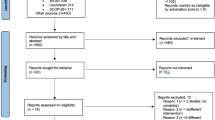Abstract
Data sources PubMed/Medline, Scopus and Cochrane databases supplemented by hand searches in the journals; Clinical Oral Implants Research, Journal of Oral Rehabilitation, The Journal of Prosthetic Dentistry, Journal of Prosthodontics and Journal of Dentistry.
Study Selection Randomised controlled clinical trials (RCTs), prospective studies with ≥ ten participants and follow-up periods ≥ six months, published in English, and comparing splinted and unsplinted attachment systems within the same study.
Data extraction and synthesisTwo investigators independently performed the electronic search; of which one collected the data while the other investigator verified it. A third investigator was involved in cases of disagreement. The Kappa test was also used to determine the inter-examiner agreement. The risk of bias was analysed using the Cochrane Risk of Bias Tool and the Newcastle-Ottawa scale.
Results Nine studies were included; six RCTs, two prospective studies and one crossover study, involving the placement of 984 implants in 380 patients and a mean follow-up period of five years. All implants were placed in the mandibular arch. The included studies demonstrated a low or unclear risk of bias. Both splinted and unsplinted attachment systems performed similarly, with no statistically significant differences present in marginal bone loss, complications and implant survival.
Conclusions The choice of attachment system does not seem to influence marginal bone loss, the incidence of complications or implant survival in mandibular overdentures.
Similar content being viewed by others
A Commentary on
Leão RS, Moraes SLD, Vasconcelos BCE, Lemos CAA, Pellizzer EP.
Splinted and unsplinted overdenture attachment systems: A systematic review and meta-analysis. J Oral Rehabil 2018; 45: 647-656. doi: 10.1111/joor.12651. Epub 2018 Jun 7. Review. PubMed PMID: 29761853.

GRADE rating
Commentary
Edentulism affects a substantial cohort of the world's population, with an estimated prevalence of 0.1% to 14.4% in younger age groups and 2.1% to 32.3% in older groups, and is significantly associated with depression and poor self-rated health.1The McGill consensus in 2002 established that mandibular two implant-retained overdentures are, not only a valid management modality but indeed a gold standard of care for edentulous patients. Nonetheless, the decision to rely on a splinted bar attachment system or an unsplinted system of ball, telescopic crown or magnetic attachments for overdenture retention remains challenging due to the range of existing variables and available options. Hence, this timely systematic review2aimed to assist the decision-making process, comparing three clinical outcomes of splinted versus unsplinted overdenture attachment systems. Implant survival rate and marginal bone loss were the primary outcomes compared, while prosthetic complications were a secondary outcome of the investigation.
The review was well performed; involving registration with PROSPERO, adherence to the PRISMA guidelines, the inclusion of three databases supplemented by hand searches, inter-examiner agreement evaluation and a clear assessment of bias using the Cochrane Risk of Bias Tool and the Newcastle-Ottawa scale. Nonetheless, the exclusion of retrospective studies and studies not published in English has limited the robustness of the review, resulting in only 380 participants in nine studies included in the review. Further complicating matters is the evident heterogeneity between the included studies, with variability in the number and type of implants, connection type, loading protocol, and follow-up periods. As a result, the authors rightly acknowledged the potential influence this evident heterogeneity and lack of standardisation had on the analyses of the meta-analysis, concluding that the findings of this review need to be interpreted with caution. Similarly, a recent Cochrane review investigating prosthodontic and patient-related outcomes of different attachment systems for maxillary and mandibular attachment systems was unable to perform any meta-analyses due to the heterogeneity of included studies. Accordingly, the Cochrane review determined that there is insufficient evidence to support improved performance and outcomes of any specific attachment system.3
The current review helps clinicians understand the limited influence splinting of overdenture attachments has on implant survival. Accordingly, as part of the decision-making process, other treatment planning considerations such as alignment and location of implants should guide the rehabilitation choice, as opposed to concerns of marginal bone loss.4 Furthermore, several other factors play a crucial role in the overall prosthetic management of edentulous patients and the intervention's long-term success. Oral hygiene,5 smoking,6 number, location and angulation of implants,7,8,9 connection type,10 existing type of bony defects11 and loading protocol12 are all potential risk factors with a more significant influence on the survival and success of implant-retained overdenture than splinting. Whilst the current review offers some insight into the limited impact of splinting on the success of treatment yet, an evidence-based, standardised guidance for prosthetic rehabilitation using overdentures remains lacking.
References
Leão RS, Moraes SL, Vasconcelos BC, Lemos CA, Pellizzer E.P. Splinted and unsplinted overdenture attachment systems: A systematic review and meta-analysis. J Oral Rehabil 2018; 45: 647-656.
Tyrovolas S, Koyanagi A, Panagiotakos DB, et al. Population prevalence of edentulism and its association with depression and self-rated health. Sci Rep 2016; 6: 37083.
Payne AG, Alsabeeha NH, Atieh MA, Esposito M, Ma S, Anas El-Wegoud MA. Interventions for replacing missing teeth: attachment systems for implant overdentures in edentulous jaws. Cochrane Database Syst Rev 2018; 10: CD008001.
Gherlone EF, Sannino G, Rapanelli A, Crespi R, Gastaldi G, Capparé P. Prefabricated bar system for immediate loading in edentulous patients: A 5-year follow-up prospective longitudinal study. BioMed Res Int 2018; 2018: 7352125.
Seo Y H, Bae EB, Kim JW, et al. Clinical evaluation of mandibular implant overdentures via Locator implant attachment and Locator bar attachment. J Adv Prosthodont 2016; 8: 313-320.
Balaguer J, Ata-Ali J, Peñarrocha-Oltra D, García B, Peñarrocha-Diago M. Long-term survival rates of implants supporting overdentures. J Oral Implantol 2015; 41: 173-177.
Bryant SR, Walton JN, MacEntee MI. A 5-year randomized trial to compare 1 or 2 implants for implant overdentures. J Dent Res 2015; 94: 36-43.
Geckili O, Cilingir A, Erdogan O, et al. The influence of interimplant distance in mandibular overdentures supported by two implants on patient satisfaction and quality of life. Int J Prosthodont 2015; 28: 19-21.
Karbach J, Hartmann S, Jahn-Eimermacher A, Wagner W. Oral health-related quality of life in edentulous patients with two-vs four-locator-retained mandibular overdentures: A prospective, randomized, crossover study. Int J Oral Maxillofac Implants 2015; 30: 1143-1148.
Lemos CAA, Verri FR, Bonfante EA, Santiago Júnior JF, Pellizzer EP. Comparison of external and internal implant-abutment connections for implant-supported prostheses. A systematic review and meta-analysis. J Dent. 2018; 70: 14-22.
Ding Q, Zhang L, Geraets W, et al. Association between peri-implant bone morphology and marginal bone loss: a retrospective study on implant-supported mandibular overdentures. Int J Oral Maxillofac Implants 2017; 32: 147-155.
Schincaglia GP, Rubin S, Thacker S, Dhingra A, Trombelli L, Ioannidou E. Marginal bone response around immediate- and delayed-loading implants supporting a locator-retained mandibular overdenture: A randomized controlled study. Int J Oral Maxillofac Implants 2016; 31: 448-458.
Author information
Authors and Affiliations
Corresponding author
Rights and permissions
About this article
Cite this article
Ahmed, K. Splinted versus unsplinted overdenture attachment systems - no difference in clinical outcomes. Evid Based Dent 20, 28–29 (2019). https://doi.org/10.1038/s41432-019-0006-9
Published:
Issue Date:
DOI: https://doi.org/10.1038/s41432-019-0006-9



